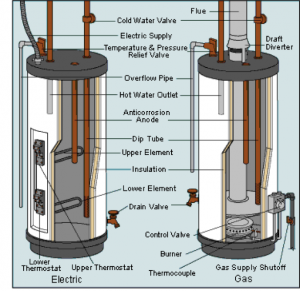
There is an inevitability about the cost of geyser maintenance and replacement: the owner concerned is liable for anything the body corporate’s insurer does not pay! It’s useful to understand the provisions that make for this “no place to hide” situation.
Most modern residential schemes have the geyser inside the section, so in terms of section 44(1)(c), it’s clear maintenance is the owner’s responsibility.
Another common arrangement is that the geysers are located in the roof space and supply one or a group of sections.
In very big buildings, particularly older ones, the hot water is often supplied to all sections from one or more boilers, usually located in a basement or boiler room. The maintenance of this system is clearly the body corporate’s responsibility and costs paid out of the administrative fund.
It is the situation where the geyser serves one or a small group of sections and is located on common property that is the most interesting.
Because section 37(1)(j) makes maintenance of the common property the responsibility of the body corporate, on the face of it the geyser on the common property is also the body corporate’s responsibility, both operationally and financially. But no! Enter prescribed management rule 68(1)(vii).
PMR 68(1)(vii) makes a number of provisions in one quite long sentence. Here it is:
“(1) In addition to his obligations in terms of section 44 of the Act, an owner-
(vii) shall maintain the hot water installation which serves his section, or, where such installation serves more than one section, the owners concerned shall maintain such installation pro-rata, notwithstanding that such appliance is situated in part of the common property and is insured in terms of the policy taken out by the body corporate.”
Let’s break it down:
a. Owner to maintain the geyser that serves his or her section.
b. If the geyser serves more than one section, those owners maintain it pro-rata.
c. The owner or owners must maintain the geyser that supplies their sections even though it might be on common property.
d. The owner or owners must maintain the geyser that serves their sections even though it is included in the body corporate building insurance policy.
1. The first part is clear and applies to geysers on common property and to geysers inside sections – although that is a reiteration of a detail covered by section 44(1)(c).
2. This part is clear enough and incidentally applies to the boiler situation.
3. This is the main point of this provision and is necessary because of section 37(1)(j). The body corporate must maintain the common property but geysers on common property are the exception. Really, the provision exists to make that exception, which is fair since geysers inside sections must be maintained by the owners of those sections.
4. The last statement is an interesting inclusion. I guess it takes care of an objecting owner holding that since the geyser is insured by the body corporate, the body corporate must maintain it, no matter where it’s located.
Geysers are traditionally included in building insurance and the premium is paid by the body corporate but not the excess payments that result from a claim against the insurer. There are two ways that is ensured.
First, if the geyser is inside the section, PMR 29(4) applies. The rules says an owner is responsible for any excess payment for claims against the body corporate building insurance in respect of his or her section, unless the body corporate has made this a specific exception to the rule, and that can only be done by special resolution.
Secondly, PMR 68(1)(vii)’s shifting the maintenance responsibility for an installation on common property to the owner concerned also means that any excess applied to a claim for a geyser on common property must be paid by the owner or owners of the sections supplied by that geyser.
No matter which way one looks at it, owners have to call the plumber and pay for their geyser maintenance!
Image source: hometips.com
Article reference: Paddocks Press: Volume 10, Issue 9, Page 2.
Anton Kelly is an extremely knowledgeable specialist Sectional Title and HOA teacher and consultant. Having been the lead teacher on all the Paddocks courses for the last 5 years, Anton lives and breathes Sectional Title and HOA law, all day every day. There are not many issues he hasn’t come across before.
This article is published under the Creative Commons Attribution license.
Recent Posts
Recent Comments
- Graham Paddock on Body Corporate Functions: Insurance
- Graham Paddock on Spending body corporate funds
- Graham Paddock on The Levy Clearance Certificate: The Body Corporate’s Cheap & Effective Weapon
- Graham Paddock on The benefits of online sectional title meetings
- Heinz Wiesner on The benefits of online sectional title meetings
Archives
- April 2024
- March 2024
- February 2024
- January 2024
- December 2023
- November 2023
- October 2023
- September 2023
- August 2023
- July 2023
- June 2023
- May 2023
- April 2023
- March 2023
- February 2023
- January 2023
- December 2022
- November 2022
- October 2022
- September 2022
- August 2022
- July 2022
- June 2022
- May 2022
- April 2022
- March 2022
- February 2022
- January 2022
- December 2021
- November 2021
- October 2021
- September 2021
- August 2021
- July 2021
- June 2021
- May 2021
- April 2021
- March 2021
- February 2021
- January 2021
- December 2020
- November 2020
- October 2020
- September 2020
- August 2020
- July 2020
- June 2020
- May 2020
- April 2020
- March 2020
- February 2020
- January 2020
- December 2019
- November 2019
- October 2019
- September 2019
- August 2019
- July 2019
- June 2019
- May 2019
- April 2019
- March 2019
- February 2019
- January 2019
- December 2018
- November 2018
- October 2018
- September 2018
- August 2018
- July 2018
- June 2018
- May 2018
- April 2018
- March 2018
- February 2018
- January 2018
- December 2017
- November 2017
- October 2017
- September 2017
- August 2017
- July 2017
- June 2017
- May 2017
- April 2017
- March 2017
- February 2017
- January 2017
- December 2016
- November 2016
- October 2016
- September 2016
- August 2016
- July 2016
- June 2016
- May 2016
- April 2016
- March 2016
- February 2016
- January 2016
- December 2015
- November 2015
- October 2015
- September 2015
- August 2015
- July 2015
- June 2015
- May 2015
- April 2015
- March 2015
- February 2015
- January 2015
- December 2014
- November 2014
- October 2014
- September 2014
- August 2014
- July 2014
- June 2014
- May 2014
- April 2014
- March 2014
- February 2014
- January 2014
- December 2013
- November 2013
- October 2013
- September 2013
- August 2013
- July 2013
- June 2013
- May 2013
- April 2013
- March 2013
- February 2013
- January 2013
- December 2012
- November 2012
- October 2012
- September 2012
- August 2012
- July 2012
- June 2012
- May 2012
- April 2012
- March 2012
- February 2012
- January 2012
- December 2011
- November 2011
- October 2011
- September 2011
- August 2011
- July 2011
- June 2011
- May 2011
- April 2011
- March 2011
- February 2011
- January 2011
- December 2010
- November 2010
- October 2010
- September 2010
- August 2010
- July 2010
- June 2010
- May 2010
- April 2010
- March 2010
- February 2010
- January 2010
- December 2009
- November 2009
- October 2009
- September 2009
- August 2009
- July 2009
- June 2009
- March 2009
- February 2009
- February 2008
- February 2007


2 Comments.
Hi Anton the body corporate of our sectional title complex decided a few years ago before we bought the unit that they would not insure the geysers. Is this legally allowed
Regards Ross Century21
Dear Ross,
Thank you for your comment. We are more than happy to help, however we do not give free opinions / advice. Please email us on consulting@paddocks.co.za with regards to your matter, and we can provide you with a no-obligation quote, so that we can assist you. Alternatively, join us on http://www.paddocks-club.co.za.
Kind regards,
Paddocks